
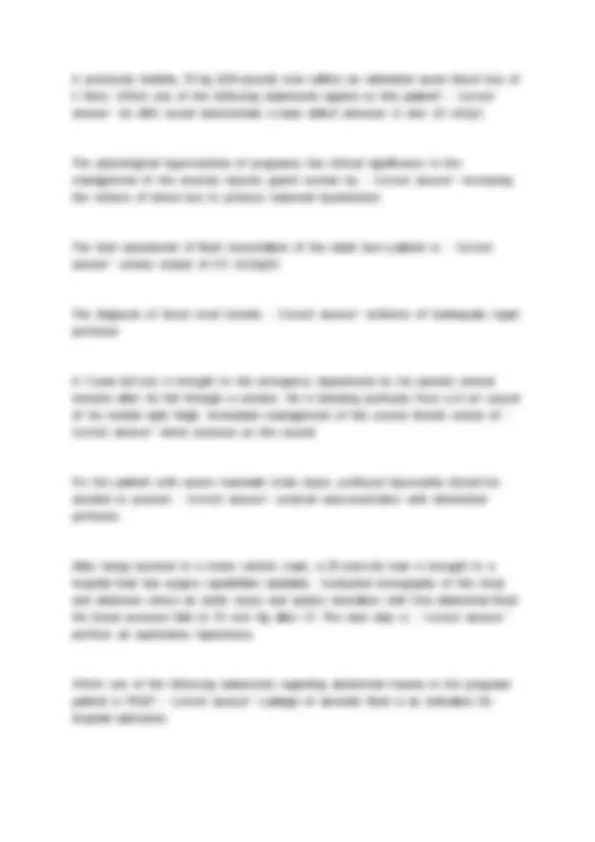
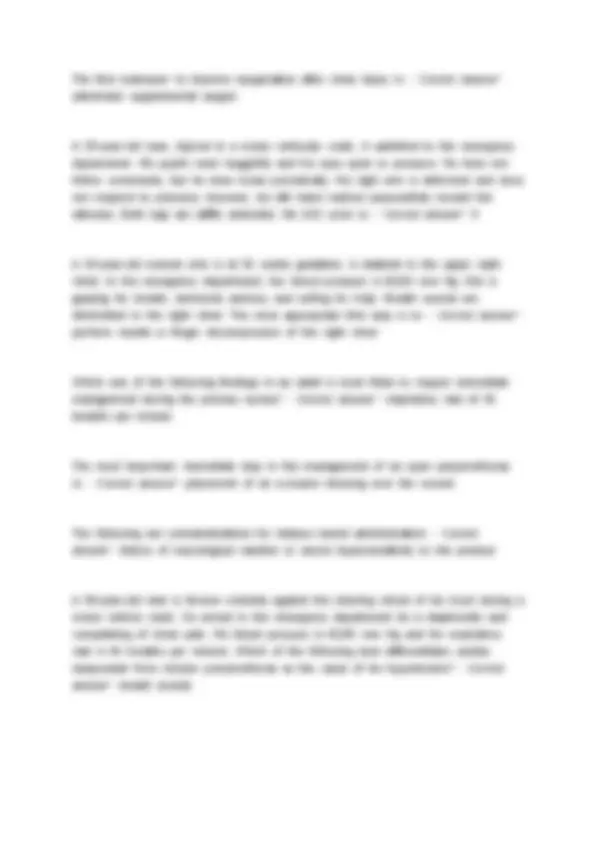
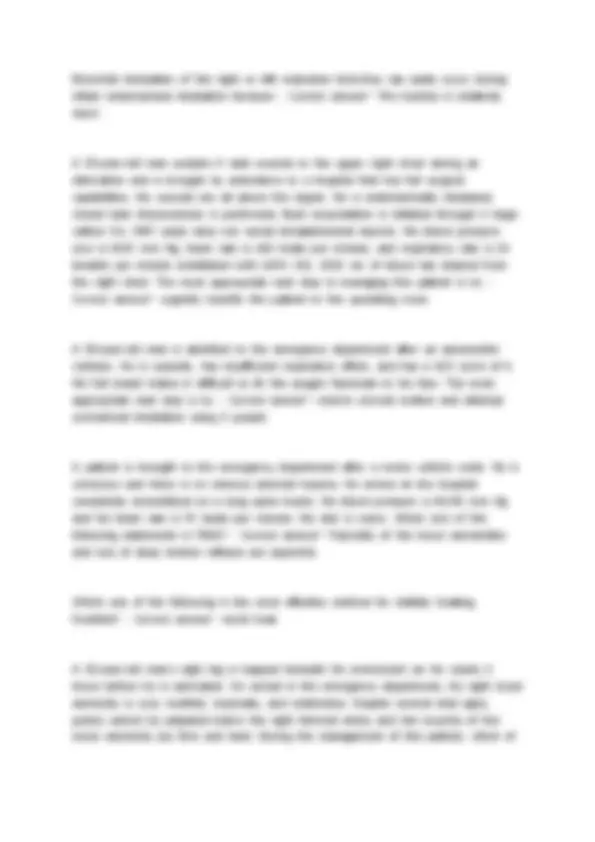
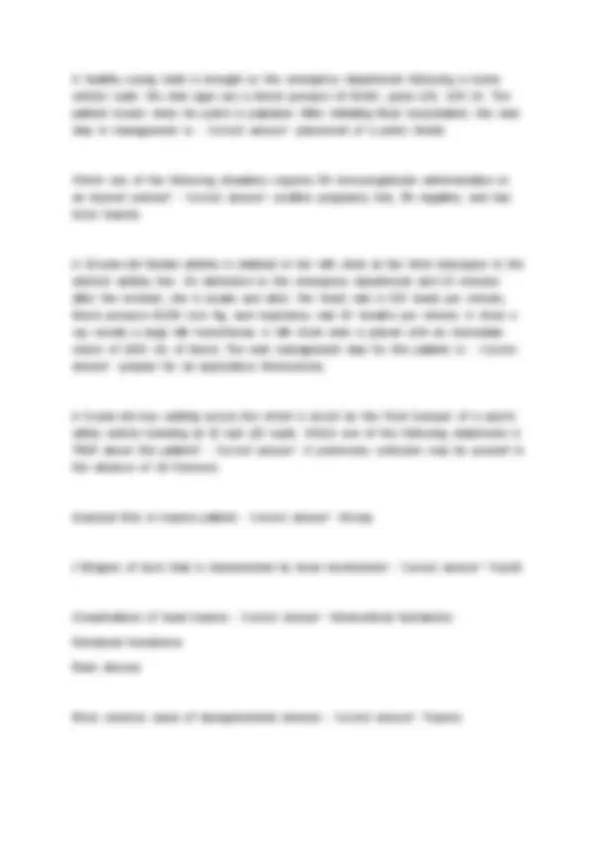
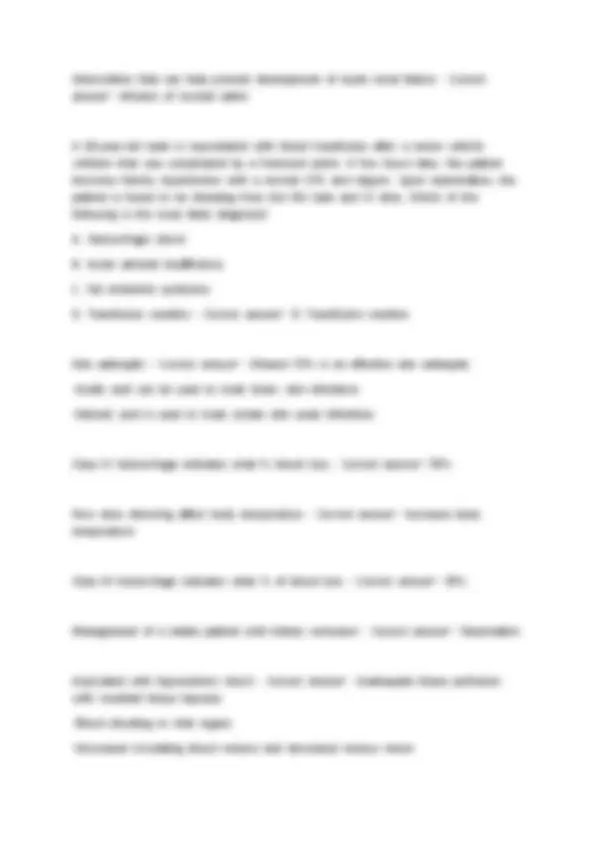
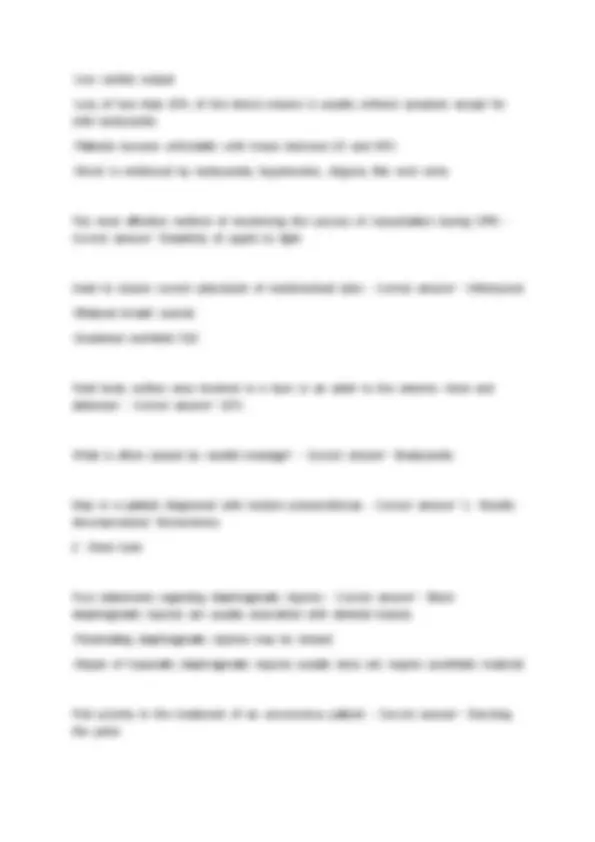
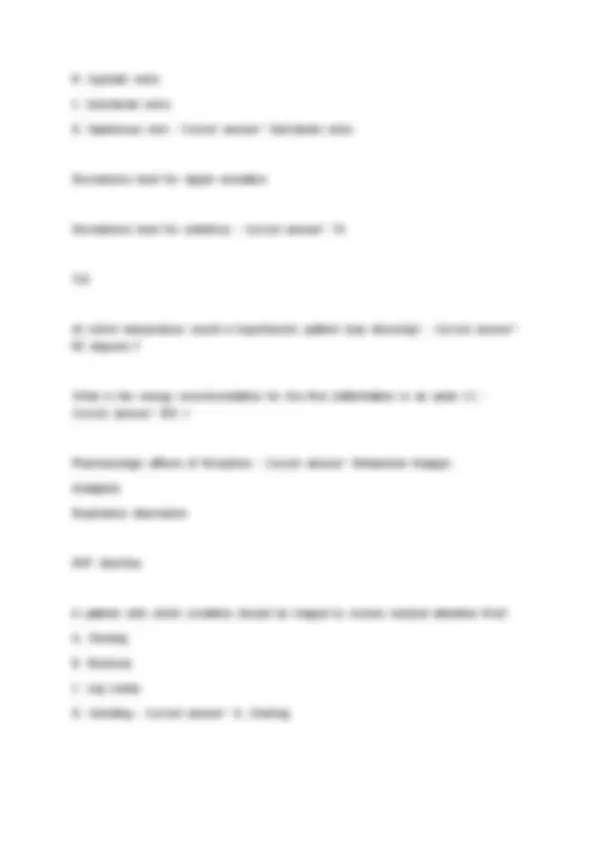
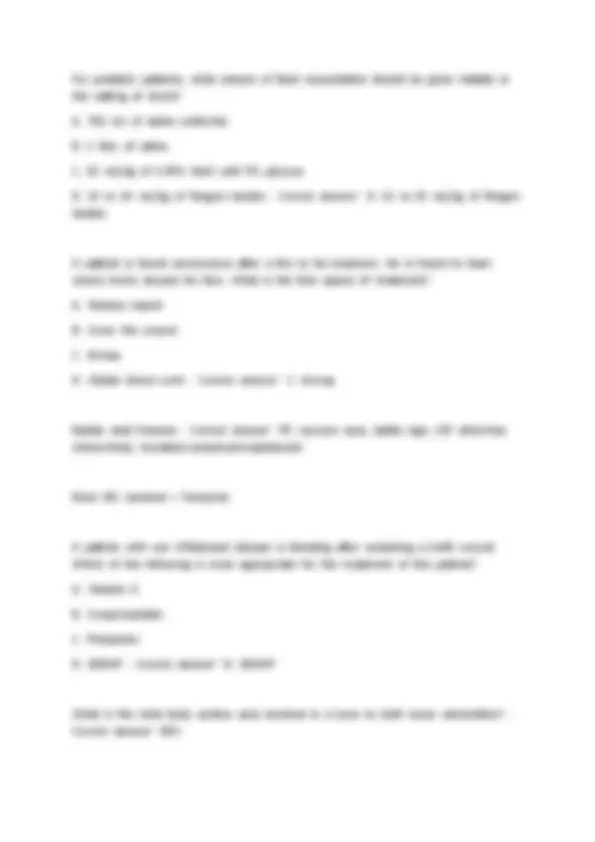
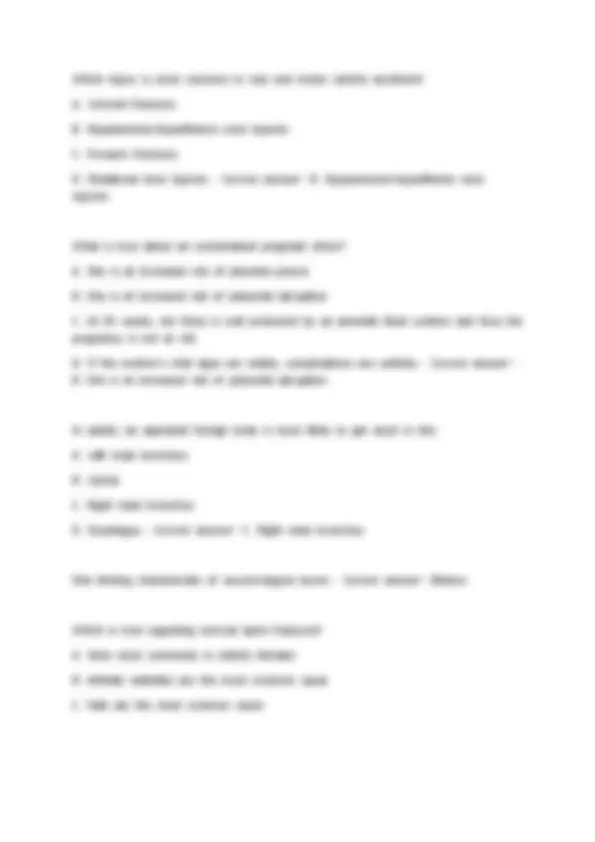
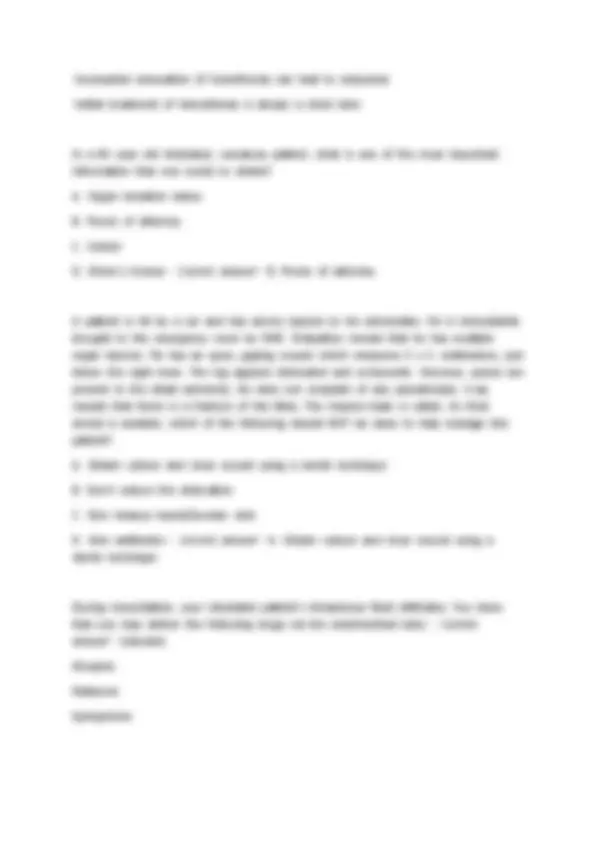
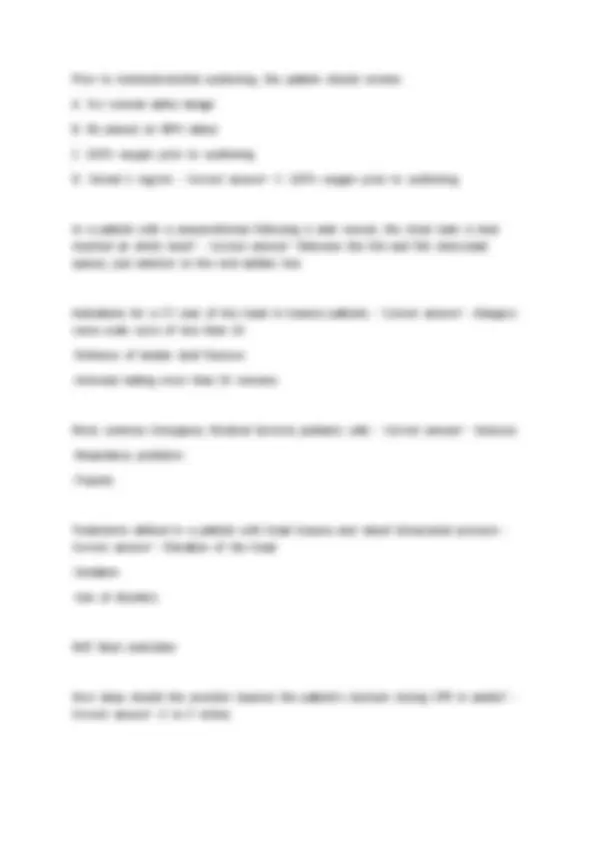
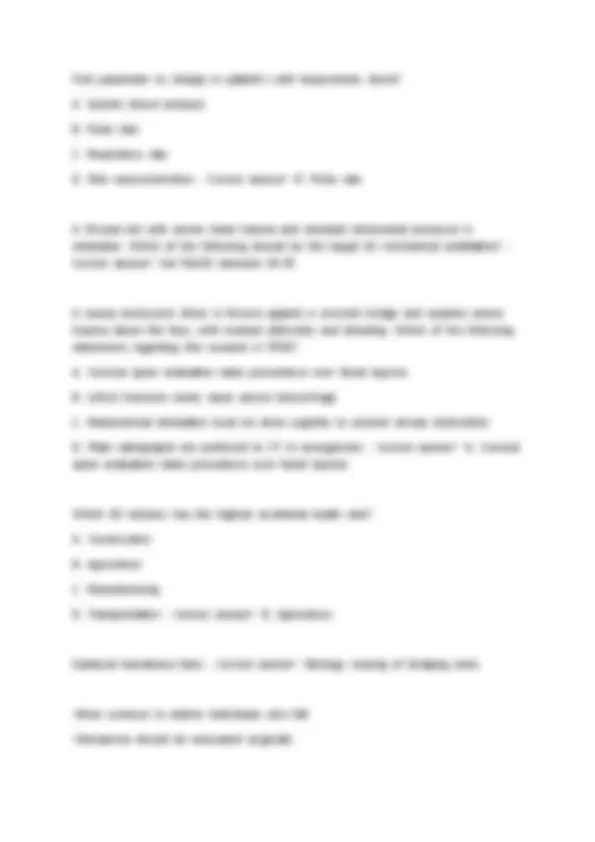
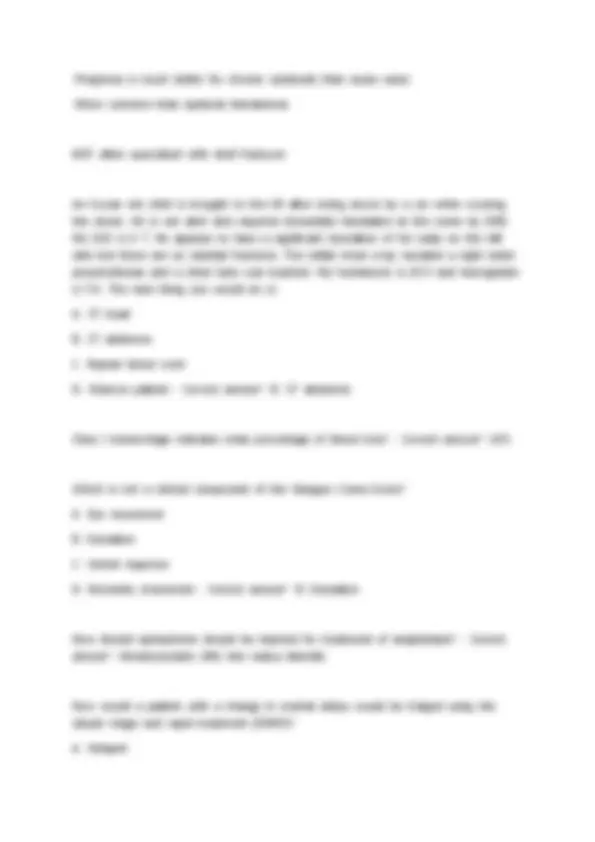
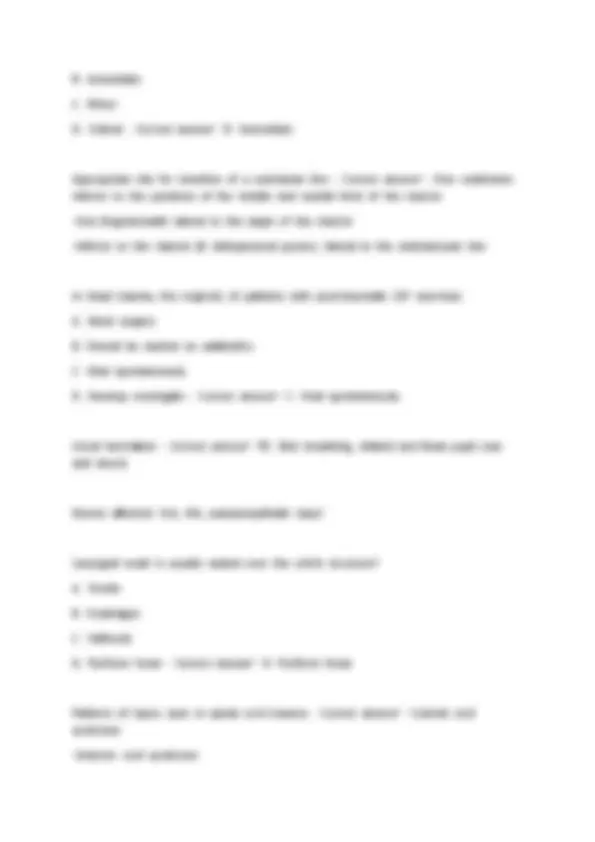
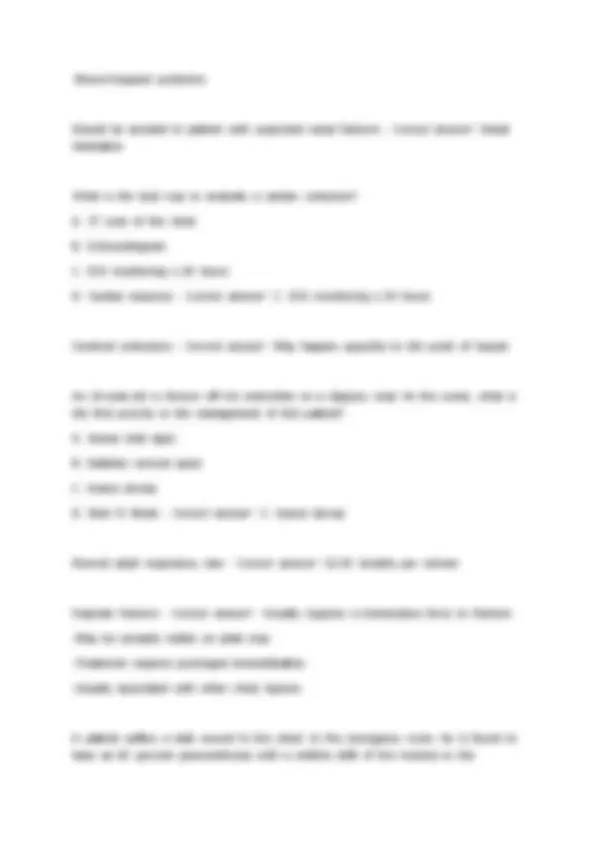
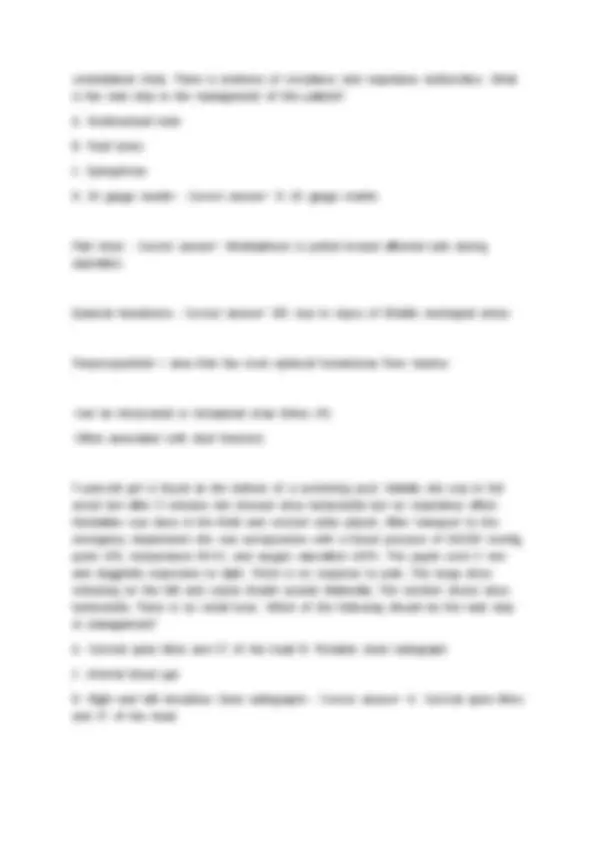
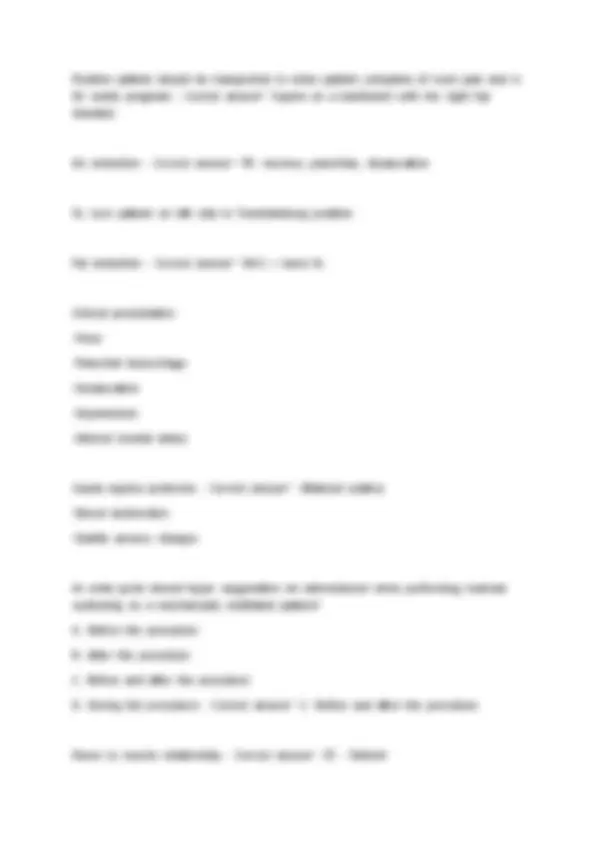
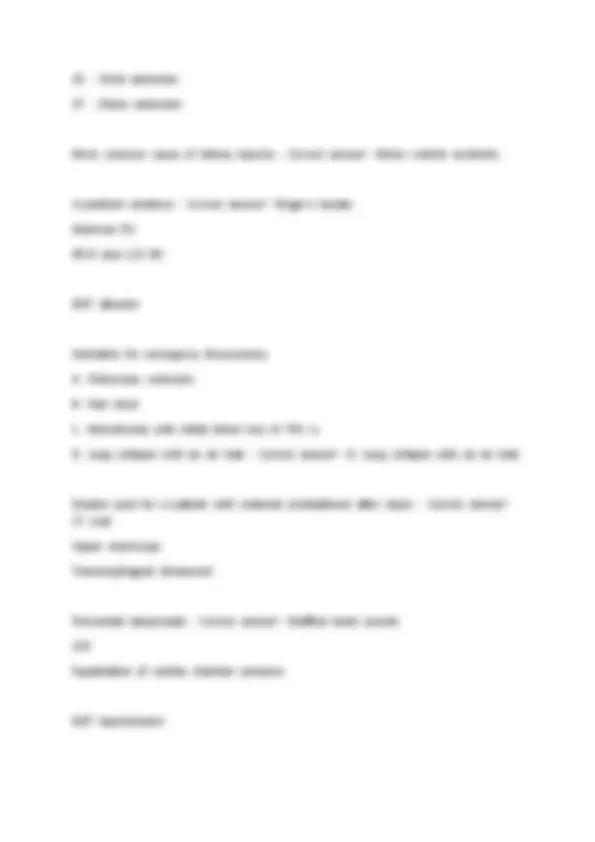
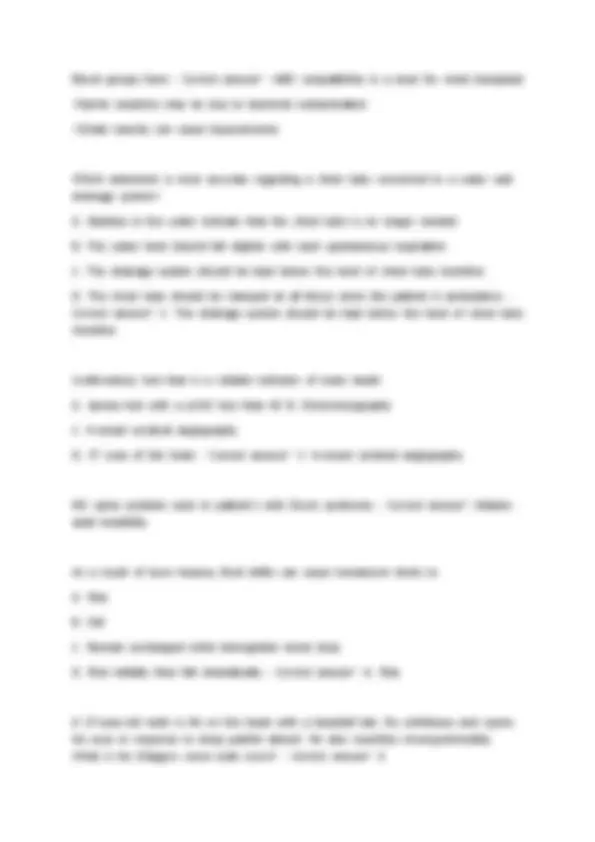
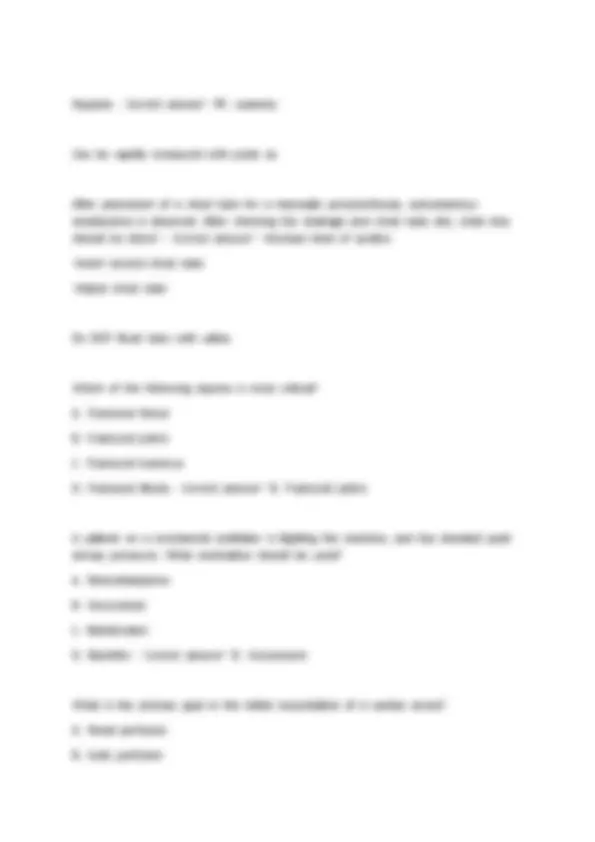
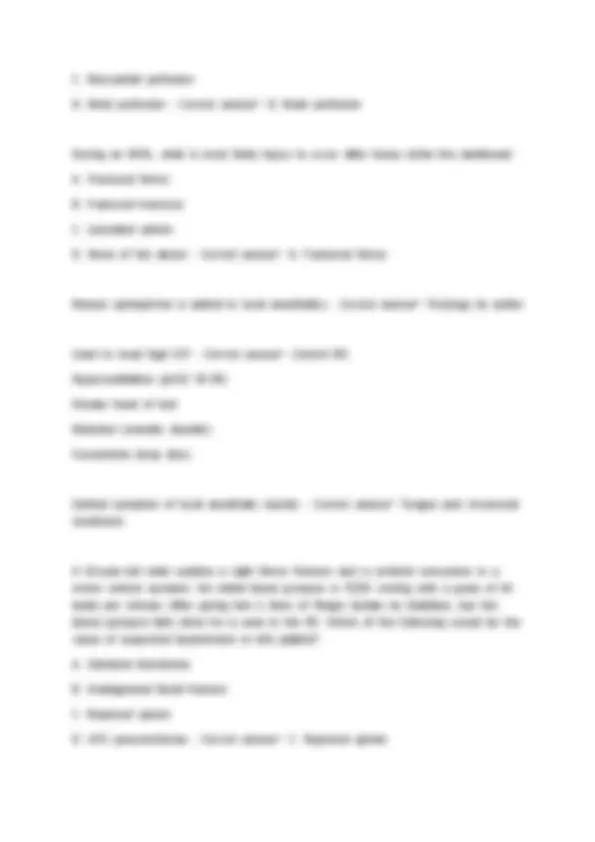
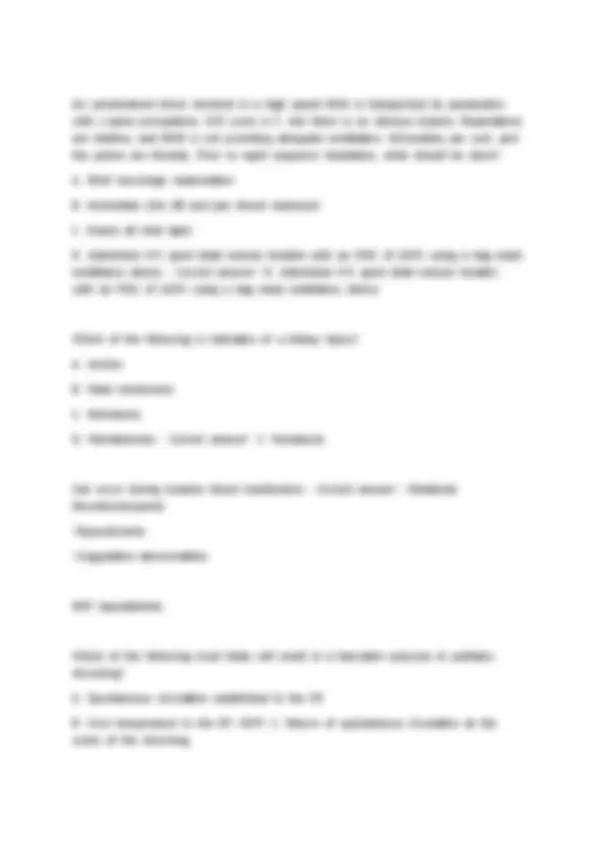
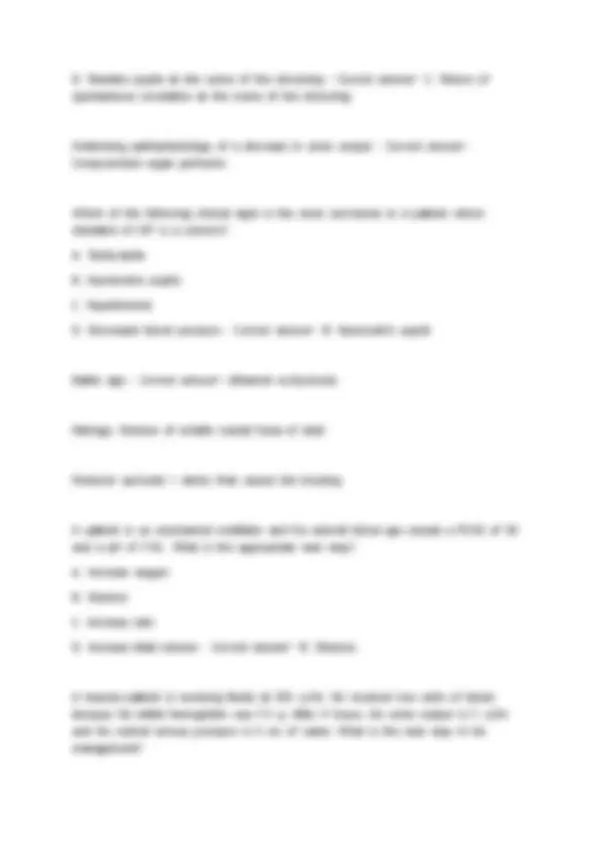
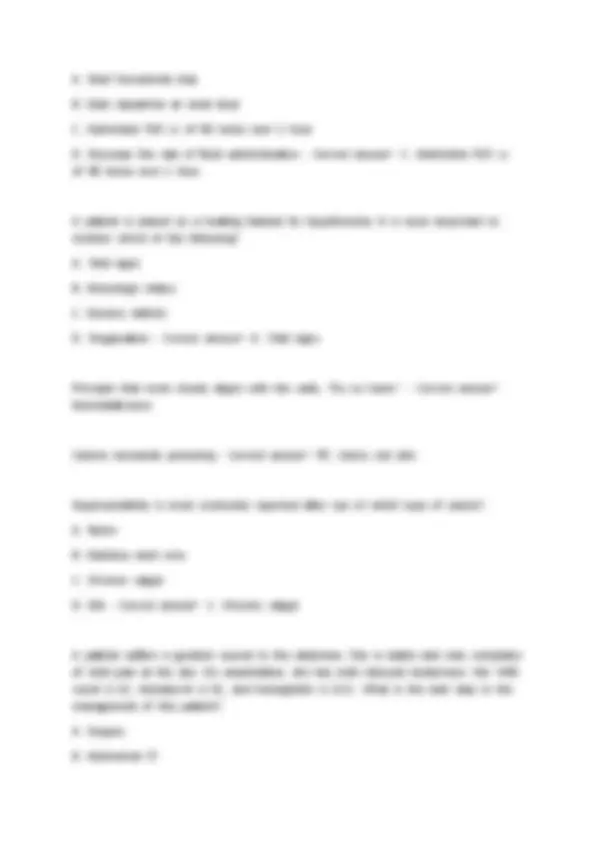
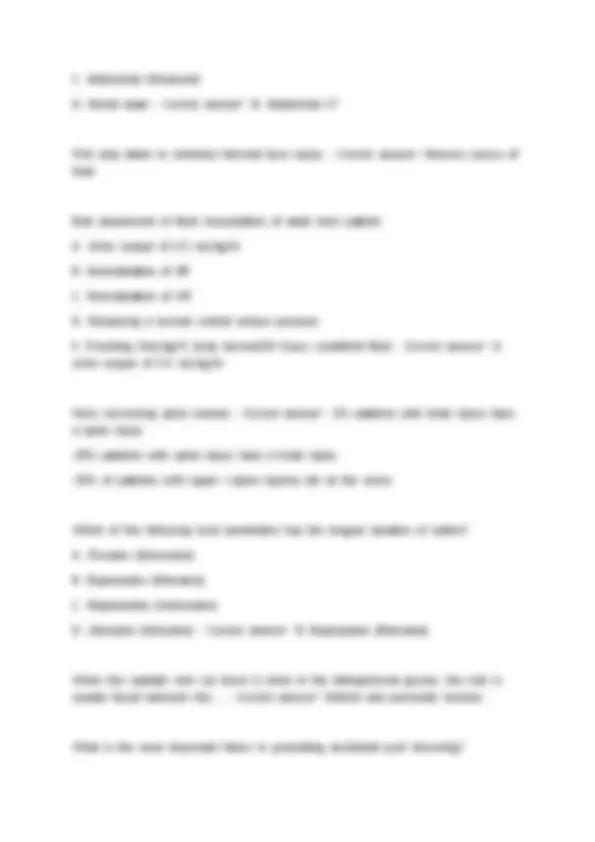
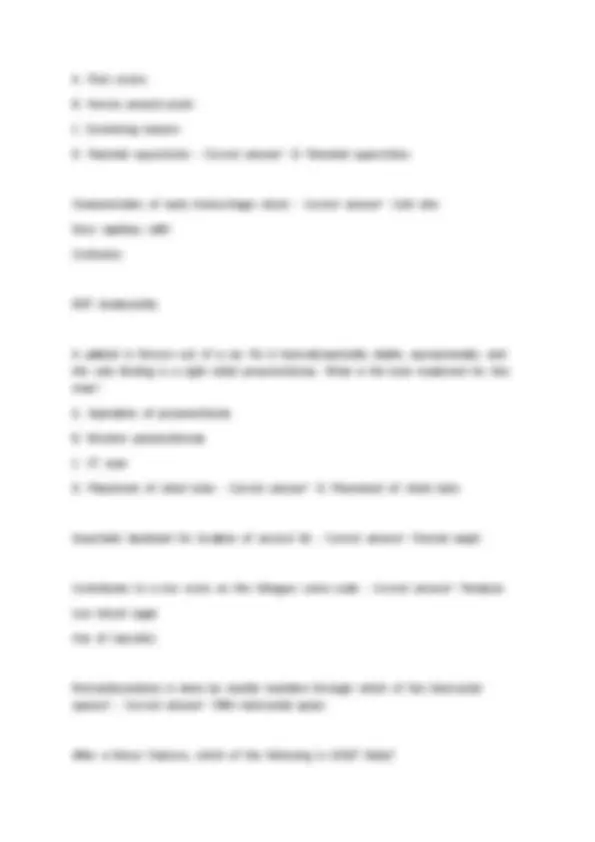
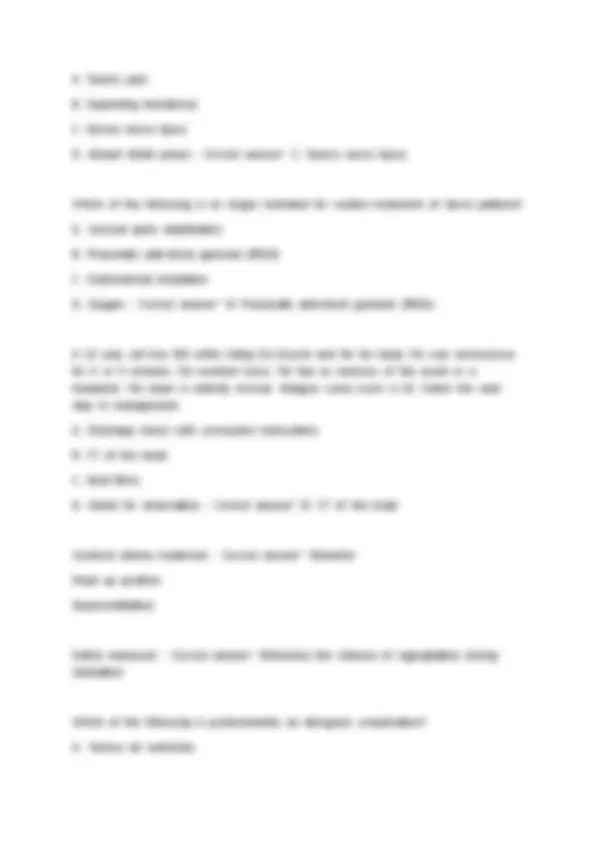
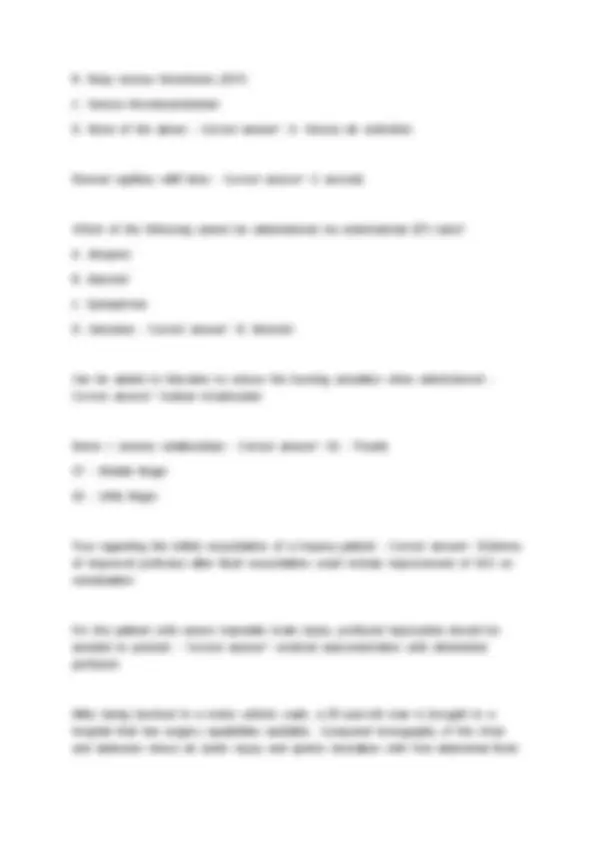
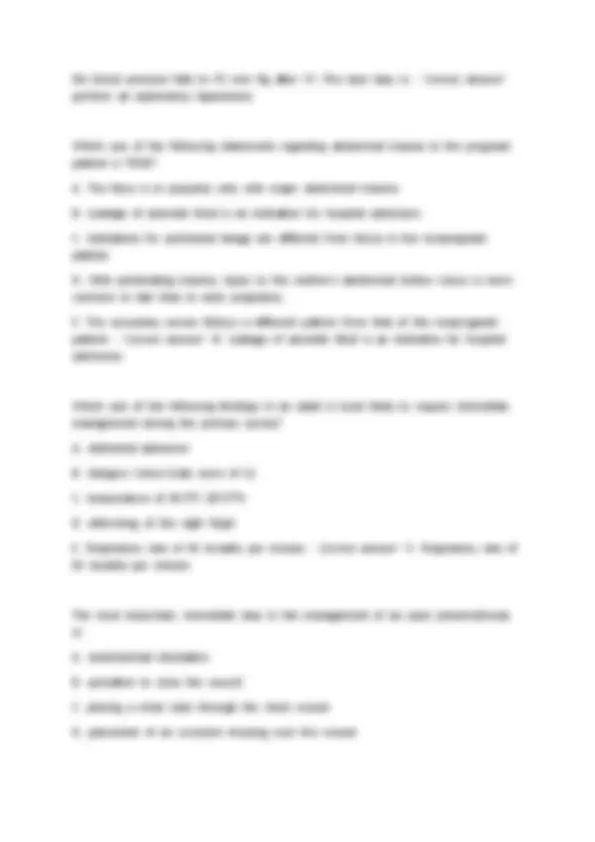
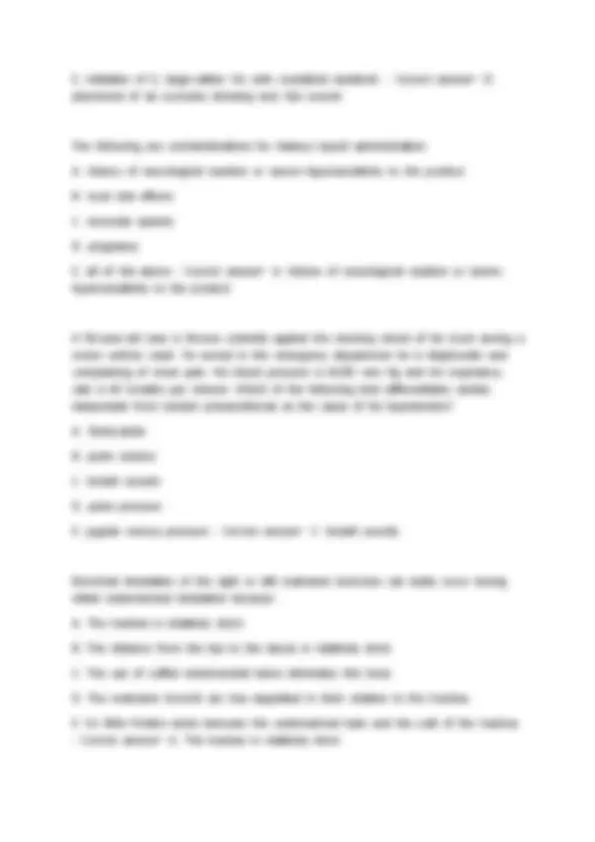
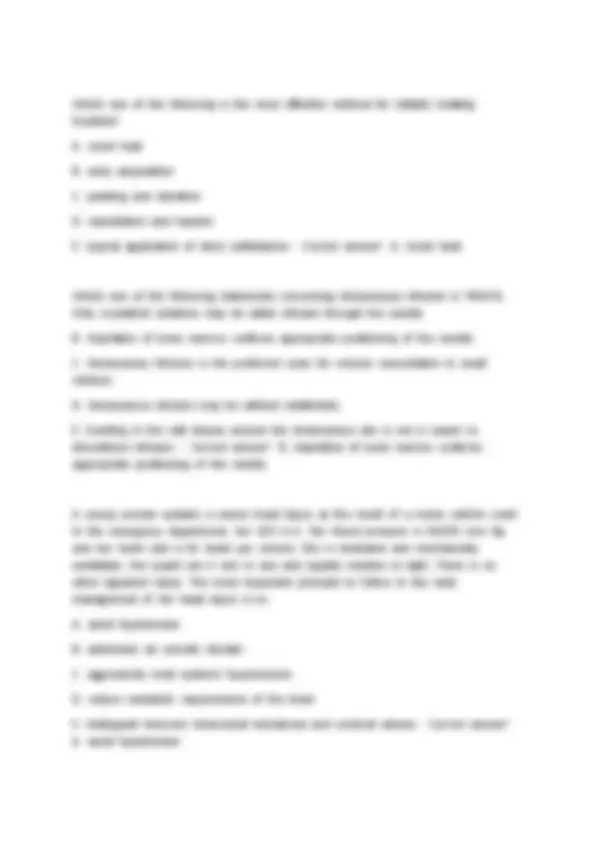
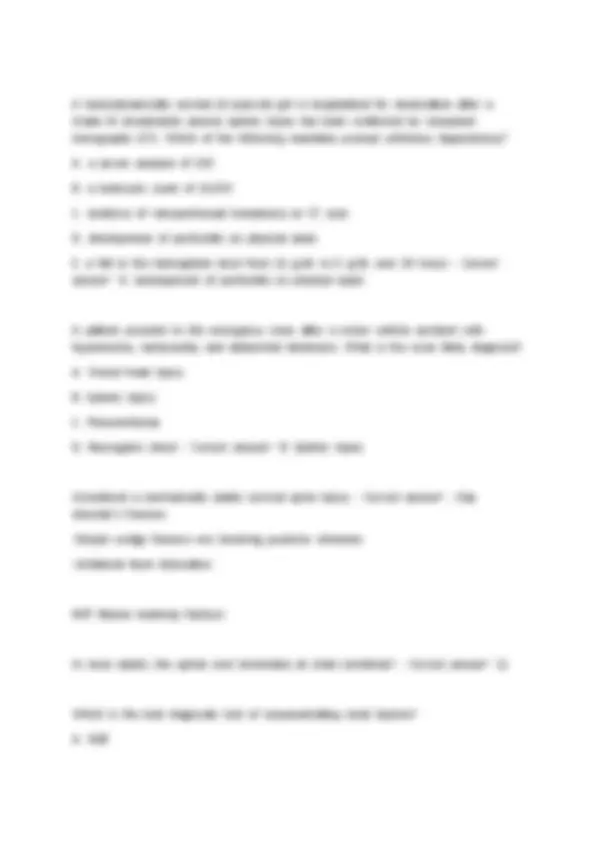

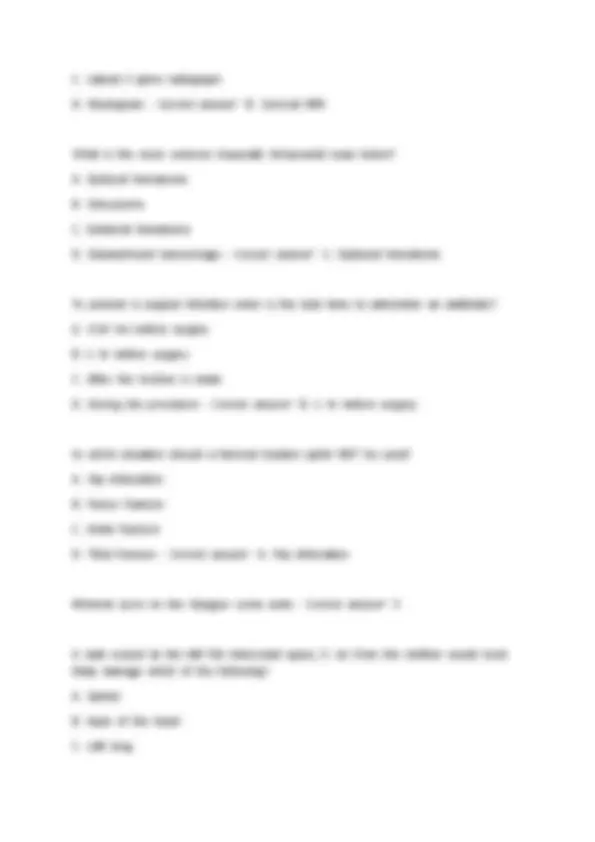
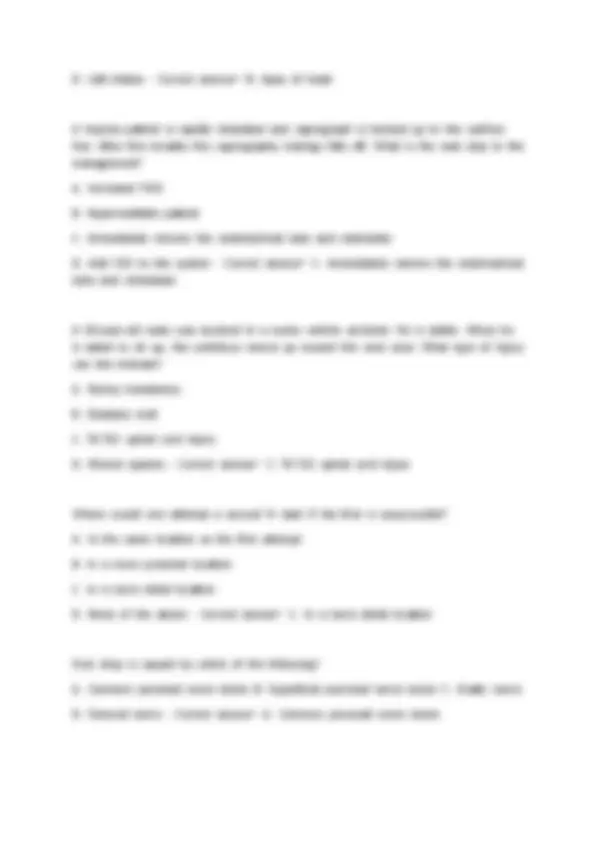
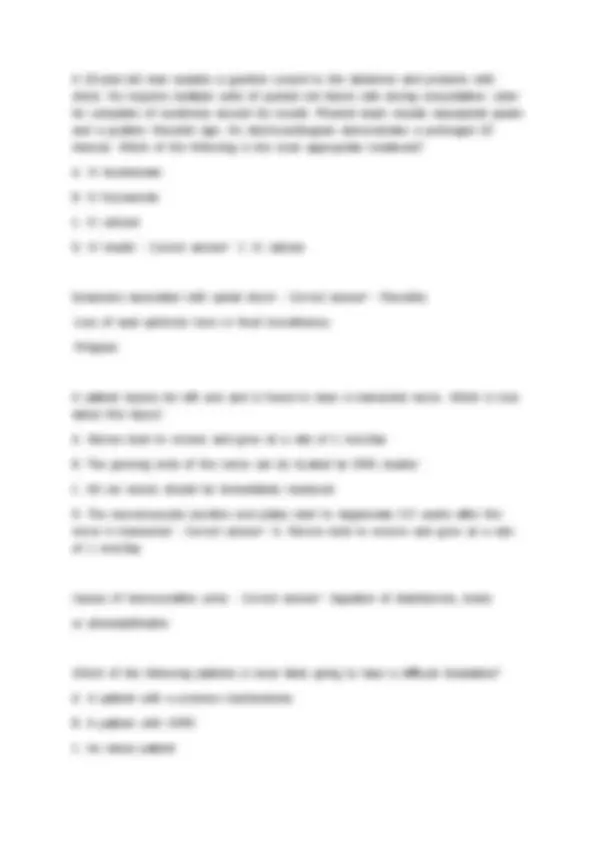
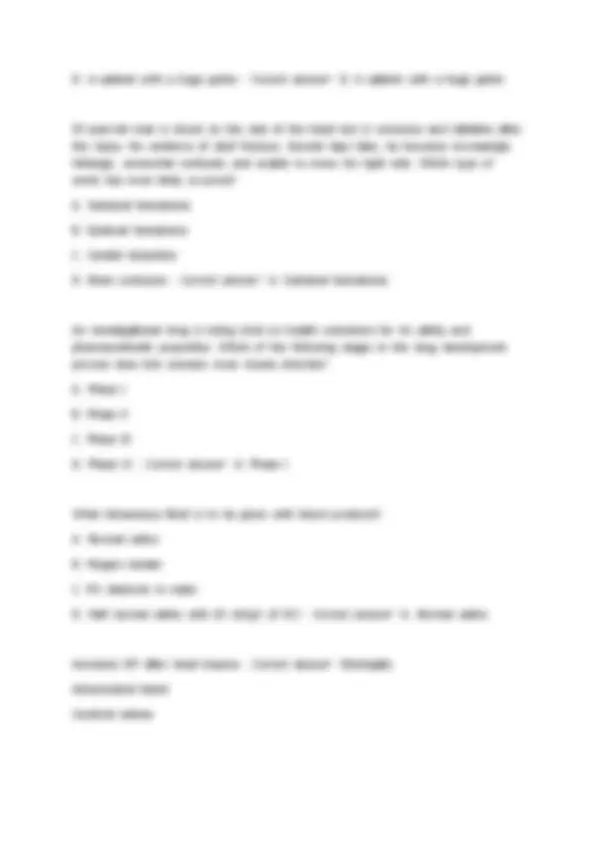
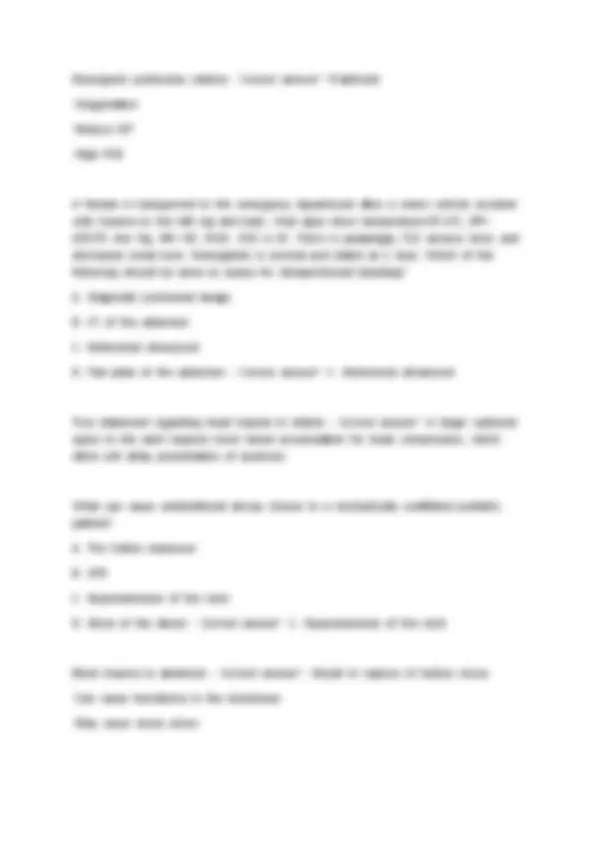
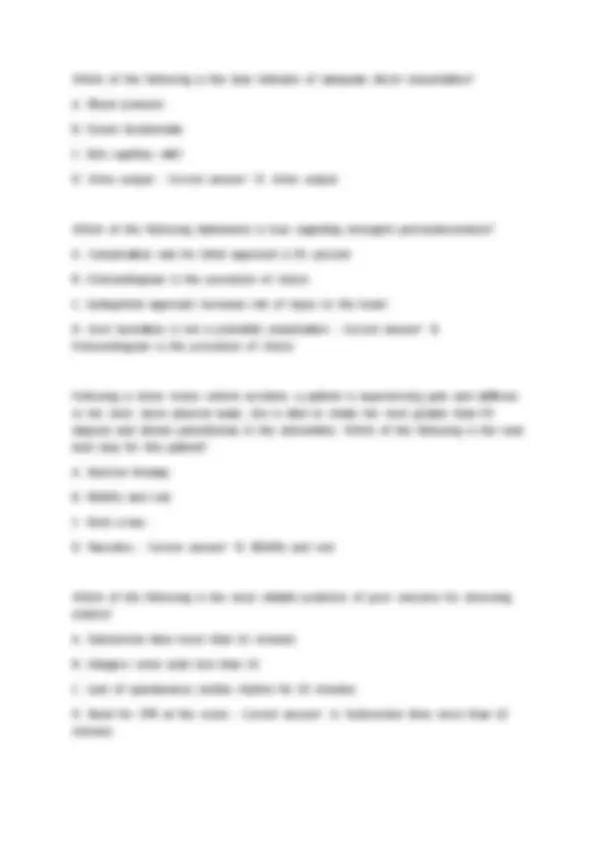
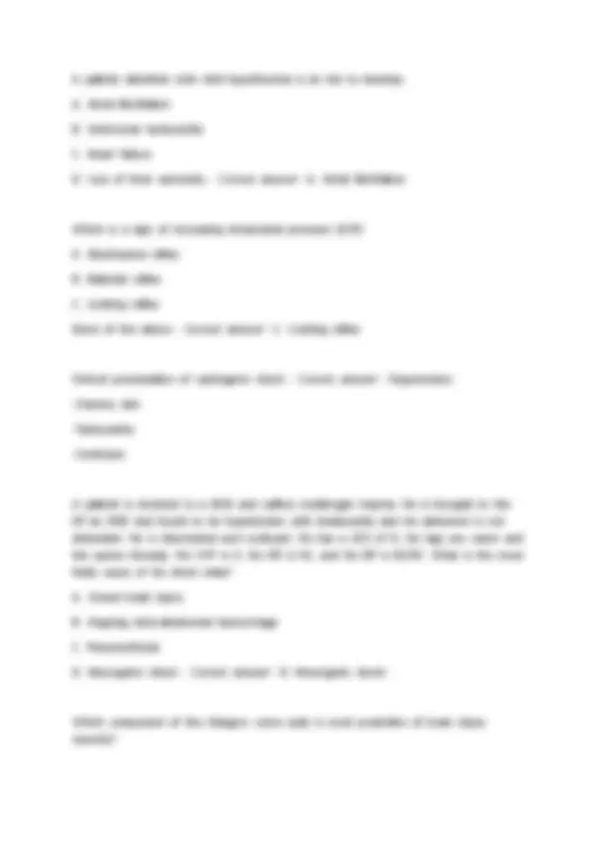
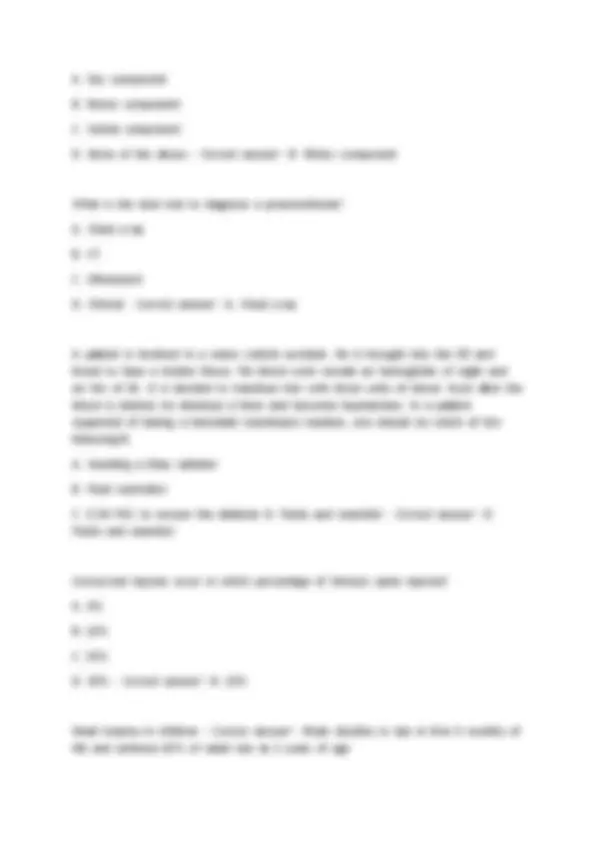
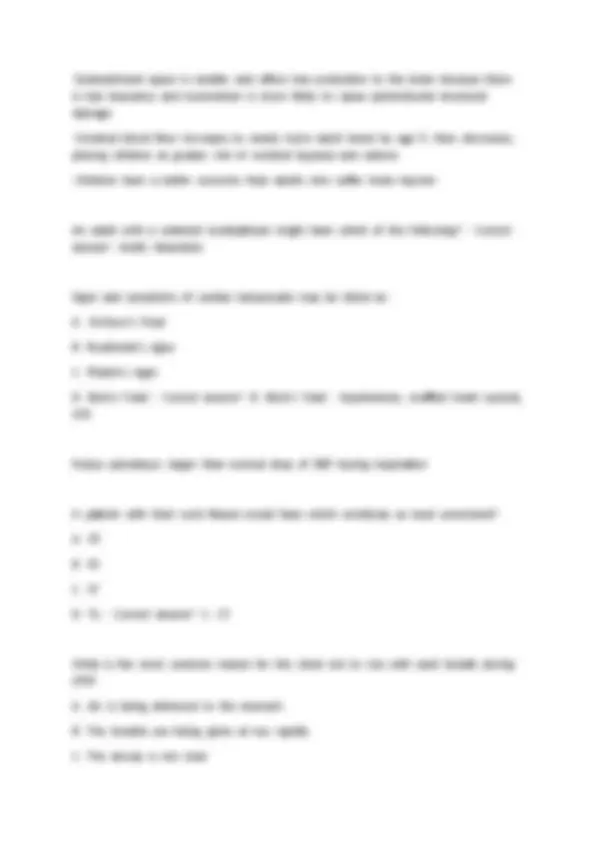
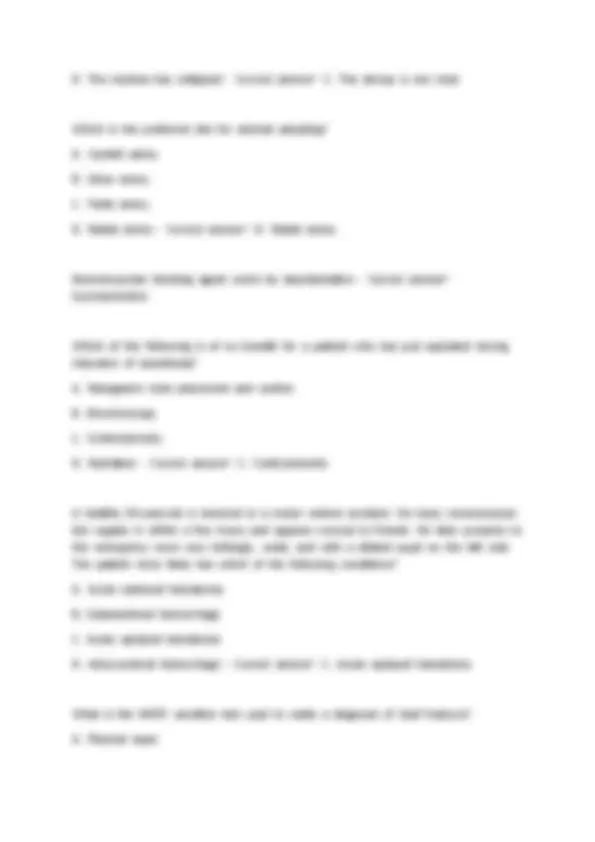
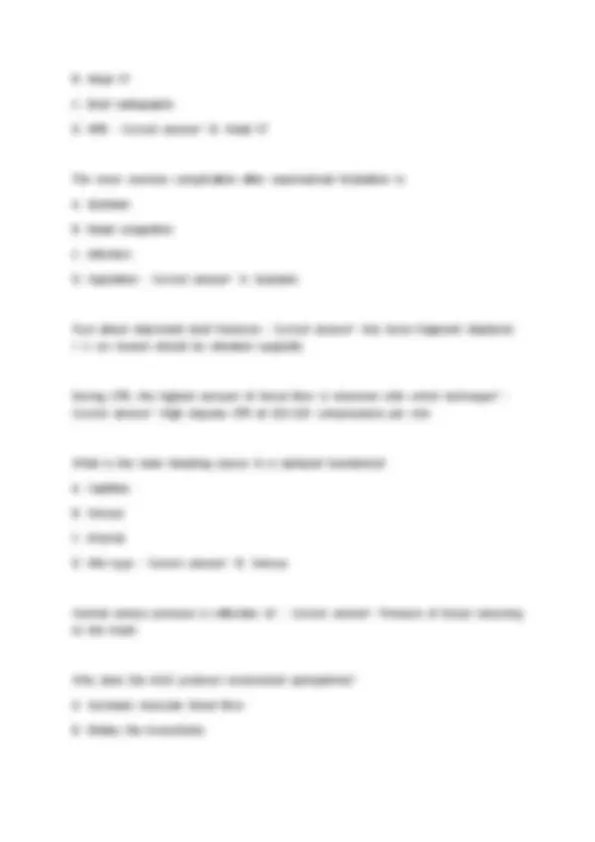
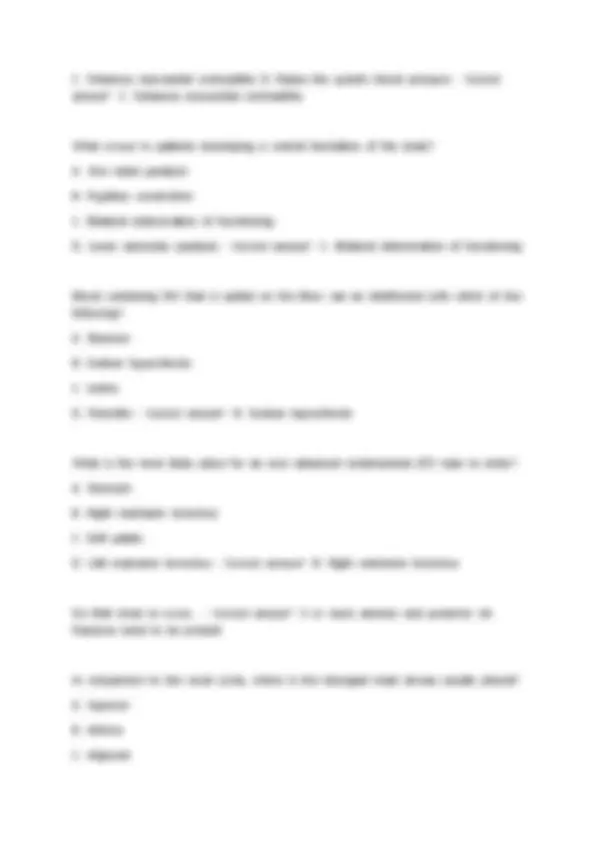
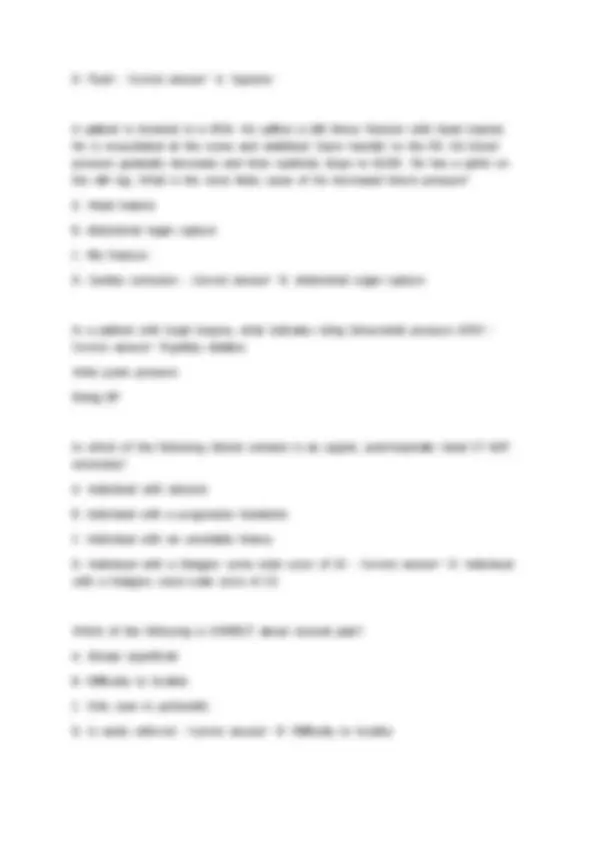
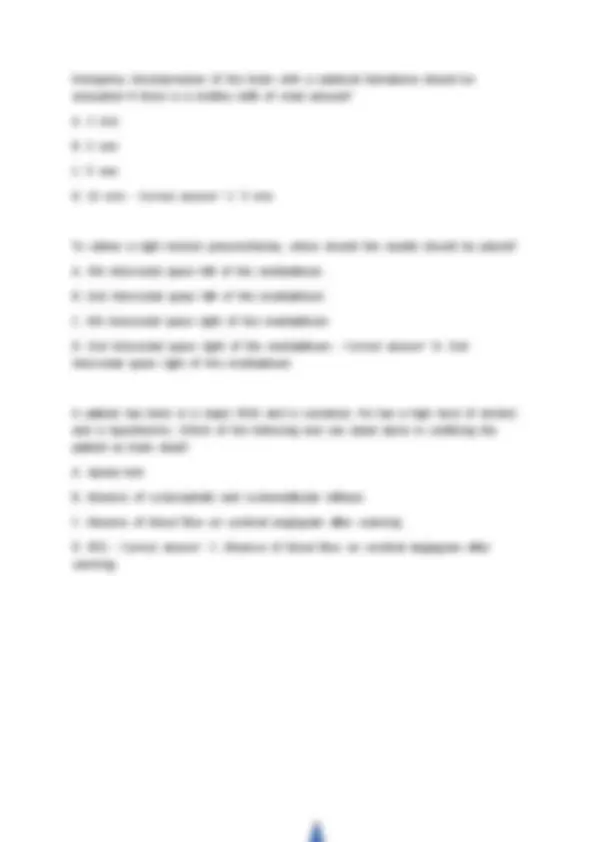


Study with the several resources on Docsity

Earn points by helping other students or get them with a premium plan


Prepare for your exams
Study with the several resources on Docsity

Earn points to download
Earn points by helping other students or get them with a premium plan
Community
Ask the community for help and clear up your study doubts
Discover the best universities in your country according to Docsity users
Free resources
Download our free guides on studying techniques, anxiety management strategies, and thesis advice from Docsity tutors
ATLS PRACTICE TEST QUESTIONS 2025.pdf
Typology: Exams
1 / 55

This page cannot be seen from the preview
Don't miss anything!
















































A 22 - year-old man is hypotensive and tachycardic after a shotgun wound to the left shoulder. His blood pressure is initially 80/40 mm Hg. After initial fluid resuscitation his blood pressure increases to 122/84 mm Hg. His heart rate is now 100 beats per minute and his respiratory rate is 28 breaths per minute. A tube thoracostomy is performed for decreased left chest breath sounds with the return of a small amount of blood and no air leak. After chest tube insertion, the most appropriate next step is: - Correct answer~ re-examine the chest A construction worker falls two stories from a building and sustains bilateral calcaneal fractures. In the emergency department, he is alert, vital signs are normal, and he is complaining of severe pain in both heels and his lower back. Lower extremity pulses are strong and there is no other deformity. The suspected diagnosis is most likely to be confirmed by: - Correct answer~ complete spine x-ray series Which of the following is true regarding the initial resuscitation of a trauma patient?
The first maneuver to improve oxygenation after chest injury is: - Correct answer~ administer supplemental oxygen A 25 - year-old man, injured in a motor vehicular crash, is admitted to the emergency department. His pupils react sluggishly and his eyes open to pressure. He does not follow commands, but he does moan periodically. His right arm is deformed and does not respond to pressure; however, his left hand reaches purposefully toward the stimulus. Both legs are stiffly extended. His GCS score is: - Correct answer~ 9 A 20 - year-old woman who is at 32 weeks gestation, is stabbed in the upper right chest. In the emergency department, her blood pressure is 80/60 mm Hg. She is gasping for breath, extremely anxious, and yelling for help. Breath sounds are diminished in the right chest. The most appropriate first step is to: - Correct answer~ perform needle or finger decompression of the right chest Which one of the following findings in an adult is most likely to require immediate management during the primary survey? - Correct answer~ respiratory rate of 40 breaths per minute The most important, immediate step in the management of an open pneumothorax is: - Correct answer~ placement of an occlusive dressing over the wound The following are contraindications for tetanus toxoid administration: - Correct answer~ history of neurological reaction or severe hypersensitivity to the product A 56 - year-old man is thrown violently against the steering wheel of his truck during a motor vehicle crash. On arrival in the emergency department he is diaphoretic and complaining of chest pain. His blood pressure is 60/40 mm Hg and his respiratory rate is 40 breaths per minute. Which of the following best differentiates cardiac tamponade from tension pneumothorax as the cause of his hypotension? - Correct answer~ breath sounds
Bronchial intubation of the right or left mainstem bronchus can easily occur during infant endotracheal intubation because: - Correct answer~ The trachea is relatively short. A 23 - year-old man sustains 4 stab wounds to the upper right chest during an altercation and is brought by ambulance to a hospital that has full surgical capabilities. His wounds are all above the nipple. He is endotracheally intubated, closed tube thoracostomy is performed, fluid resuscitation is initiated through 2 large- caliber IVs. FAST exam does not reveal intraabdominal injuries. His blood pressure now is 60/0 mm Hg, heart rate is 160 beats per minute, and respiratory rate is 14 breaths per minute (ventilated with 100% O2). 1500 mL of blood has drained from the right chest. The most appropriate next step in managing this patient is to: - Correct answer~ urgently transfer the patient to the operating room A 39 - year-old man is admitted to the emergency department after an automobile collision. He is cyanotic, has insufficient respiratory effort, and has a GCS score of 6. His full beard makes it difficult to fit the oxygen facemask to his face. The most appropriate next step is to: - Correct answer~ restrict cervical motion and attempt orotracheal intubation using 2 people A patient is brought to the emergency department after a motor vehicle crash. He is conscious and there is no obvious external trauma. He arrives at the hospital completely immobilized on a long spine board. His blood pressure is 60/40 mm Hg and his heart rate is 70 beats per minute. His skin is warm. Which one of the following statements is TRUE? - Correct answer~ Flaccidity of the lower extremities and loss of deep tendon reflexes are expected. Which one of the following is the most effective method for initially treating frostbite? - Correct answer~ moist heat A 32 - year-old man's right leg is trapped beneath his overturned car for nearly 2 hours before he is extricated. On arrival in the emergency department, his right lower extremity is cool, mottled, insensate, and motionless. Despite normal vital signs, pulses cannot be palpated below the right femoral artery and the muscles of the lower extremity are firm and hard. During the management of this patient, which of
A young woman sustains a severe head injury as the result of a motor vehicle crash. In the emergency department, her GCS is 6. Her blood pressure is 140/90 mm Hg and her heart rate is 80 beats per minute. She is intubated and mechanically ventilated. Her pupils are 3 mm in size and equally reactive to light. There is no other apparent injury. The most important principle to follow in the early management of her head injury is to: - Correct answer~ avoid hypotension A 33 - year-old woman is involved in a head-on motor vehicle crash. It took 30 minutes to extricate her from the car. Upon arrival in the emergency department, her heart rate is 120 beats per minute, BP is 90/70 mm Hg, respiratory rate is 16 breaths per minute, and her GCS score is 15. Examination reveals bilaterally equal breath sounds, anterior chest wall ecchymosis, and distended neck veins. Her abdomen is flat, soft, and not tender. Her pelvis is stable. Palpable distal pulses are found in all 4 extremities. Of the following, the most likely diagnosis is: - Correct answer~ cardiac tamponade A hemodynamically normal 10 - year-old girl is hospitalized for observation after a Grade III (moderately severe) splenic injury has been confirmed by computed tomography (CT). Which of the following mandates prompt celiotomy (laparotomy)? - Correct answer~ development of peritonitis on physical exam A 40 - year-old woman who was a restrained driver in a motor vehicle crash is evaluated in the emergency department. She is hemodynamically normal and found to be paraplegic at the level of T10. Which of the following are true regarding her evaluation and management? - Correct answer~ Log rolling using 4 people is a safe approach to restrict spinal motion when moving her. A trauma patient presents to your emergency department with inspiratory stridor and a suspected c-spine injury. Oxygen saturation is 88% on high-flow oxygen via a nonrebreathing mask. The most appropriate next step is to: - Correct answer~ restrict cervical motion and establish a definitive airway When applying the Rule of Nines to infants: - Correct answer~ The head is proportionally larger in infants than in adults.
A healthy young male is brought to the emergency department following a motor vehicle crash. His vital signs are a blood pressure of 84/60, pulse 123, GCS 10. The patient moans when his pelvis is palpated. After initiating fluid resuscitation, the next step in management is: - Correct answer~ placement of a pelvic binder Which one of the following situations requires Rh immunoglobulin administration to an injured woman? - Correct answer~ positive pregnancy test, Rh negative, and has torso trauma A 22 - year-old female athlete is stabbed in her left chest at the third interspace in the anterior axillary line. On admission to the emergency department and 15 minutes after the incident, she is awake and alert. Her heart rate is 100 beats per minute, blood pressure 80/60 mm Hg, and respiratory rate 20 breaths per minute. A chest x- ray reveals a large left hemothorax. A left chest tube is placed with an immediate return of 1600 mL of blood. The next management step for this patient is: - Correct answer~ prepare for an exploratory thoracotomy A 6 - year-old boy walking across the street is struck by the front bumper of a sports utility vehicle traveling at 32 kph (20 mph). Which one of the following statements is TRUE about this patient? - Correct answer~ A pulmonary contusion may be present in the absence of rib fractures. Assessed first in trauma patient - Correct answer~ Airway (*)Degree of burn that is characterized by bone involvement - Correct answer~ Fourth Complications of head trauma - Correct answer~ Intracerebral hematoma Extradural hematoma Brain abscess Most common cause of laryngotracheal stenosis - Correct answer~ Trauma
A patient involved in a road accident is brought to the emergency department in an unconscious state. On arrival, her vitals show a temperature of 96.4 degrees Fahrenheit, a respiration rate of 24 breaths per minute, a heart rate of 140 beats per minute, and a blood pressure of 80/40 mm Hg. She is cold, shivering, and perspiring profusely. She has bilateral reactive pupils but she does not respond to pain. On physical examination, she has no obvious sign of external bleeding. Which of the following cannot be the cause of hypotension in this patient? A. Pelvic fracture B. Fracture of femur C. Intracranial hemorrhage D. Hemothorax - Correct answer~ C. Intracranial hemorrhage A patient suffered a slash to his right neck. The wound is over the mid-portion of the sternocleidomastoid. There is a large hematoma and brisk bleeding when uncovered. He is stable. What is the next step in management? A. Get an angiogram B. Close the wound in the ER C. Take him to the operating room D. CT scan to evaluate neck structure - Correct answer~ C. Take him to the OR After abdominal injury, which of the following urinalysis findings would be an indication for further testing? A. 0 - 5 casts/HPF B. 5 - 10 WBC/HPF C. 10 - 20 RBC/HPF D. Gross hematuria - Correct answer~ D. Gross hematuria A laceration of the neck superficial to the deep cervical fascia along the sternocleidomastoid muscle at its midpoint would cause bleeding from which structure? - Correct answer~ External jugular vein
B. Cephalic veins C. Subclavian veins D. Saphenous vein - Correct answer~ Subclavian veins Dermatome level for nipple sensation Dermatome level for umbilicus - Correct answer~ T T At which temperature would a hypothermic patient stop shivering? - Correct answer~ 88 degrees F What is the energy recommendation for the first defibrillation in an adult (*) - Correct answer~ 300 J Pharmacologic effects of Morphine - Correct answer~ Behavioral changes Analgesia Respiratory depression NOT diarrhea A patient with which condition should be triaged to receive medical attention first? A. Choking B. Dizziness C. Leg cramp D. Vomiting - Correct answer~ A. Choking
For pediatric patients, what volume of fluid resuscitation should be given initially in the setting of shock? A. 750 mL of saline uniformly B. 1 liter of saline C. 20 mL/kg of 0.45% NaCl with 5% glucose D. 10 to 20 mL/kg of Ringers lactate - Correct answer~ D. 10 to 20 mL/kg of Ringers lactate A patient is found unconscious after a fire in his bedroom. He is found to have severe burns around his face. What is the first aspect of treatment? A. Tetanus toxoid B. Cover the wound C. Airway D. Obtain blood work - Correct answer~ C. Airway Basilar skull fracture - Correct answer~ PE: raccoon eyes, battle sign, CSF ottorrhea (rhinorrhea), loculated pneumoencephalocele Bone MC involved = Temporal A patient with von Willebrand disease is bleeding after sustaining a knife wound. Which of the following is most appropriate for the treatment of this patient? A. Vitamin K B. Cryoprecipitate C. Protamine D. DDAVP - Correct answer~ D. DDAVP What is the total body surface area involved in a burn to both lower extremities? - Correct answer~ 36%
D. Methylprednisolone should not be used in associated spinal cord injury in the first 48 hours - Correct answer~ D. Methylprednisolone should not be used in associated spinal cord injury in the first 48 hours In which patients can an oropharyngeal airway be used? - Correct answer~ Non-gag reflex If a trauma patient has clear fluid draining from the nose the provider should do which of the following? A. Tilt the head back B. Apply pressure C. Collect the fluid D. Insert nasal tampons - Correct answer~ C. Collect the fluid What is the estimated time a person's brain can be anoxic from cardiopulmonary failure and not develop permanent brain damage? A. 10 minutes B. 5 minutes C. 2 minutes D. 20 minutes - Correct answer~ B. 5 minutes The laryngeal mask airway is contraindicated in patients with what condition? A. Spine injury B. Head trauma C. Giving birth D. Propensity to aspirate - Correct answer~ D. Propensity to aspirate A patient sustains blunt trauma to the back and left leg. Vital signs in the emergency department show temperature 36 degrees C, BP 120/80 mm Hg, heart rate 92, respirations 19, GCS 15. There is bilateral lower extremity paraplegia, T12 sensory
level, and decreased rectal tone. Hemoglobin is 14.2 and the same in one hour. Which of the following tests is best for diagnosing an intraperitoneal bleed? A. Abdominal ultrasound B. Laparotomy C. KUB D. Diagnostic peritoneal lavage - Correct answer~ A. Abdominal ultrasound Why is tracheostomy generally not performed at the first cartilage ring A. The trachea is too narrow B. A high chance of subglottic stenosis C. A high chance of tracheo-innominate artery fistula D. Inability to access the area - Correct answer~ B. A high chance of subglottic stenosis What does a carotid pulse indicate? A. A functioning pump for blood flow B. The circulating blood volume is reaching end organs C. Diastolic blood pressure D. None of the above - Correct answer~ B. The circulating blood volume is reaching end organs Which of the following generally causes hemorrhage associated with pelvic fractures? A. Obturator artery injury B. Superior gluteal artery C. Lateral sacral artery injury D. Venous bleeding - Correct answer~ D. Venous bleeding Hemothorax facts - Correct answer~ - Must have at least 500 cc of blood to make a diagnosis on chest x-rayin an adult
Prior to tracheobronchial suctioning, the patient should receive: A. 5cc normal saline lavage B. Be placed on NPO status C. 100% oxygen prior to suctioning D. Versed 1 mg/mL - Correct answer~ C. 100% oxygen prior to suctioning In a patient with a pneumothorax following a stab wound, the chest tube is best inserted at which level? - Correct answer~ Between the 4th and 5th intercostal spaces, just anterior to the mid axillary line Indications for a CT scan of the head in trauma patients - Correct answer~ - Glasgow coma scale score of less than 14
First parameter to change in patient's with hypovolemic shock? A. Systolic blood pressure B. Pulse rate C. Respiratory rate D. Skin vasoconstriction - Correct answer~ B. Pulse rate A 34 - year-old with severe head trauma and elevated intracranial pressures is intubated. Which of the following should be the target for mechanical ventilation? - Correct answer~ Set PaCO2 between 30 - 35 A young motorcycle driver is thrown against a concrete bridge and sustains severe trauma about the face, with marked deformity and bleeding. Which of the following statements regarding this scenario is TRUE? A. Cervical spine evaluation takes precedence over facial injuries B. LeFort fractures rarely cause severe hemorrhage C. Nasotracheal intubation must be done urgently to prevent airway obstruction D. Plain radiographs are preferred to CT in emergencies - Correct answer~ A. Cervical spine evaluation takes precedence over facial injuries Which US industry has the highest accidental death rate? A. Construction B. Agriculture C. Manufacturing D. Transportation - Correct answer~ B. Agriculture Subdural hematoma facts - Correct answer~ Etiology: tearing of bridging veins